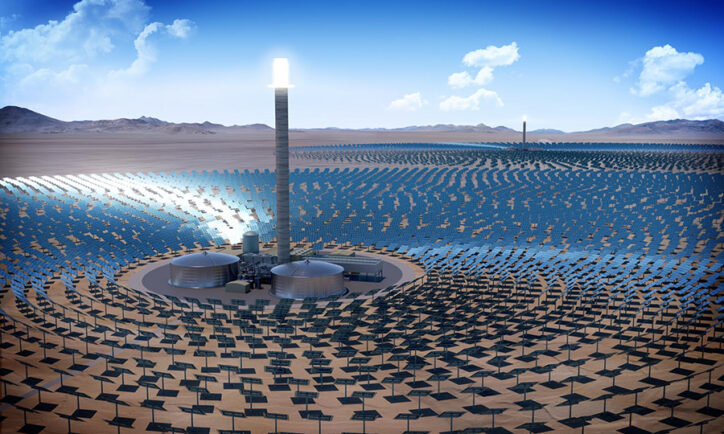
Solar energy can be used to generate electricity using different kinds of methods like solar panels. One of those methods of generating electricity from solar energy is concentrating solar power. Concentrating solar energy technology works very differently from how Pv solar panels work. One of the biggest advantages that Concentrating solar power technology offers over the PV solar panels is that CSP technology is able to store solar energy with the help of thermal energy storage systems. Thus when it comes to storing solar energy, CSP technology proves to be superior to PV solar panels.
Concentrating solar power may be more efficient in terms of production and storage but still it is not the preferred one when compared with Pv solar technology. While there is a lot of debate over which is better: CSP technology or PV solar panel technology, as of now, PV solar panels are preferred by homeowners because they are cheaper.
In this article we discuss the different aspects of CSP technology, how CSP works, what are the different types of CSP technologies available in the market, the requirements for installing CSP as well as we draw a comparison between CSP and PV technologies.
What is concentrating solar power?
Concentrating solar power is a technological method used to convert solar energy into electricity. CSP technology uses mirrors to concentrate the sunlight to increase efficiency and convert it into electricity using engines or turbines. It is one of the most efficient ways of utilizing solar energy in order to cut down on your electricity bills and also help conserve resources that go into producing electricity with the conventional sources of energy.
How does Concentrating solar power work?
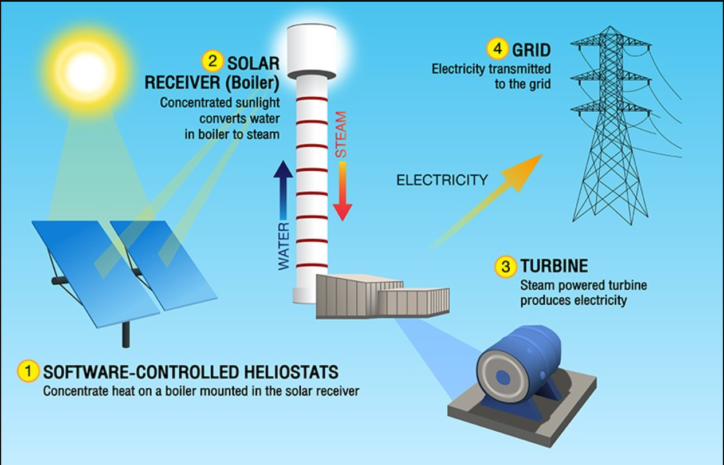
So how exactly does Concentrating solar power work? To put it simply, the CSP technology uses mirrors to concentrate and reflect the solar power. The solar energy which is concentrated using the mirrors is then directed onto a receiver. When the sunlight is concentrated it produces heat which heats up a fluid, present inside the receiver, to a very high temperature. This produces thermal heat, and this thermal heat is used to spin either a turbine or to drive a steam engine. The steam engine is further connected to an electrical power generator. In some cases the steam engine powers a thermochemical reaction, which in turn produces electricity.
The thermal energy can also be stored in the CSP plant and used as when it is required. At present there are approximately 1,815 Megawatts of Concentrating solar power plants operating in the USA. USA also houses one of the biggest CSP projects in the world at the Ivanpah Solar Power Facility (392 MW), which is just one amongst the number of CSP projects in the USA.
Since Concentrating solar power technology is essentially a power station that generates thermal energy, it is very similar to a coal or geothermal power plant. It constitutes thermal energy storage, storing solar energy in the form of sensible heat or latent heat. This allows CPS technology to generate electricity on demand and not be dependent on the presence of sunlight like PV solar panels. Thus CPS technology offers a special utilitarian advantage during peak power usage hours (after sun-down) when PV solar panels run out of solar energy to generate electricity.
What are the different types of Concentrating Solar power systems?
CSP technology has developed different systems to concentrate and convert solar energy into electricity. These technological approaches have been developed to maximise efficiency and make concentrating solar power more feasible for homeowners. These different CSP technological approaches and systems present in the market today are:
- Parabolic trough system
- Solar power towers
- Fresnel reflectors
- Dish Stirling
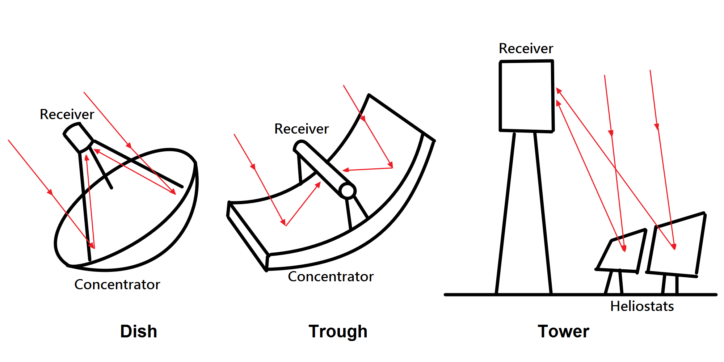
These CSP systems use different types of concentrators. The purpose here is to produce peak temperatures in order to improve efficiency. The concentrators track the sun and focus sunlight in different ways. New technological innovations in CSP technology help to make it more cost effective for use at homes and offices.
Parabolic trough system
In the parabolic trough system, curved mirrors are used to focus the solar energy onto a receiver. The receiver is in the form of a tube running down the center of the trough. This tube is filled with a transfer fluid like synthetic oil, which heats up when the solar energy is reflected onto the receiver tube. The fluid heats up to temperatures as high as 750 degree Fahrenheit or even higher. The fluid passes through a heat exchanger and is used to heat up water to produce steam. Further the setup is joined with a steam engine that is driven by the steam produced by heating the water. The steam drives the turbine or the steam engine power system to generate electricity.
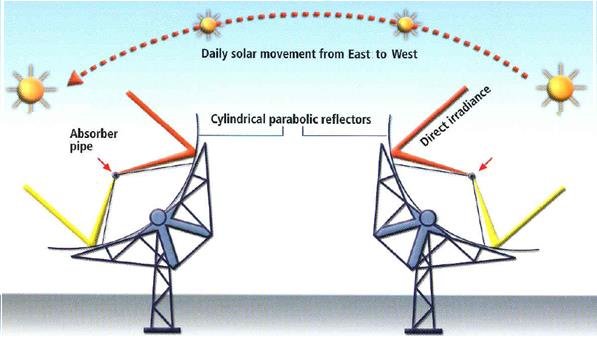
The trough system often consists of a trough solar collector field with multiple parabolic trough mirrors attached to each other in parallel rows. They are connected as a series of loops, placed on the north-south axis. This enables the trough system to track the sunlight as the sun moves from east to west, ensuring that the receiver pipes continuously receive concentrated solar energy to keep the fluid heated. An individual collector module is somewhere between 15 to 20 feet in height and 300 to 450 feet in length.
Trough systems is the most commonly used CSP technology, especially in the USA. infact USa houses the world’s first commercial parabolic trough plant in California: the Solar Energy Generating Systems (SEGS). It also has the Acciona’s Nevada solar one near Boulder city, Nevada.
Enclosed trough system:
The enclosed trough system is an extension to the parabolic trough system. It encapsulates the solar thermal system in a glasshouse similar to the greenhouse. The glasshouse improves the efficiency of the solar thermal system by protecting the plant from the element that could be detrimental to the reliability or the efficiency of the CSP plant.
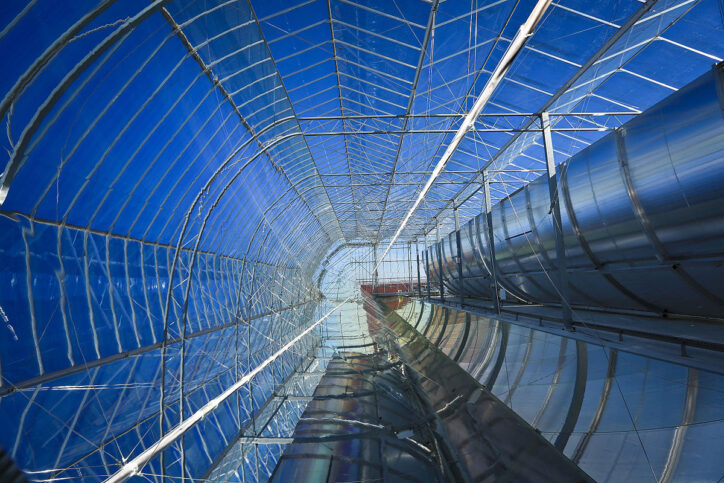
Within the glasshouse, solar reflecting mirrors are suspended. These mirrors are light and curved in order to track the sunlight and reflect it onto a network of steel tubes within the glasshouse. Steam is generated directly within the pipes as they are filled with water. The water boils in order to produce steam which runs the turbine just as in the case of the conventional parabolic trough system.the only difference in this CSP technology is that there are no heat exchangers or working fluid required to mediate the heat exchange. Another benefit that the glasshouse provides is sheltering the mirror from the wind as well as preventing dust from building up on the mirror, thus maintaining optimum efficiency.
Solar power towers:
Power tower systems, also known as central receivers, are another kind of CSP technology that uses large, flat sun-tracking mirrors known as heliostats. The heliostats focus sunlight onto a receiver which is placed on top of a tall tower. The receiver also contains a heat transferring fluid just like the other CSP systems. The fluid heats up to 500-1000 degree Celsius, and the thermal energy is used to produce electricity in a conventional turbine generator. Some power tower systems also use water or steam instead of synthetic oils as the transfer liquid. Experimentation is going on to replace the transfer fluid with molten salts or sand-like particles. This will help in maximizing the power cycle temperature.
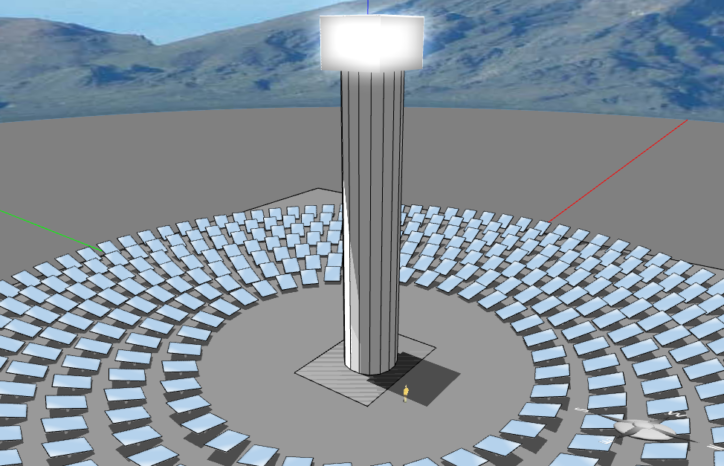
Even though the power tower CSP system is less advanced as compared to the trough system, it is preferred because of the higher efficiency that it is able to produce. Subsequently, it also has a better energy storage capability. There ongoing research to come up with other heat transfer materials as well storage materials so as to achieve higher levels of efficiency. The power tower system can produce high levels of temperatures. Researchers are trying to develop such systems that can maximize efficiency while at the same time lowering the cost of production. Materials like air, sand particles and alternative mixtures of chemicals are being considered to be used as energy storage materials.
Dish engine systems:
Dish engine systems have mirrored dishes which are used to focus sunlight onto the receiver in the CSP system. The receiver is mounted at a focal point while the concentrators are mounted on a structure with a two-axis tracking system. This allows the concentrators to track sunlight. In order to capture as much solar energy as possible, the dish engine system tracks the sun’s movement. A high efficiency combustion engine is integrated with the receiver. This engine is equipped with thin tubes that are filled with either hydrogen or helium gas.
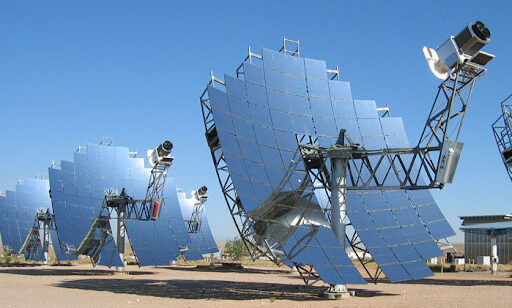
These tubes run along the engine’s piston cylinders and are attached to the cylinder in such a manner that they open into the cylinder. This is where the mechanism gets a little complicated. When sunlight falls onto the dish, it concentrates the heat and directs it onto the receiver tubes, the tubes heat up and cause the gas inside it to expand inside the cylinder. This drives the piston which turns the crankshaft. The crankshaft ultimately drives an electric generator. And this is how the solar energy captured by the dish is converted into usable electricity. The receiver, engine as well as the generator all are constituents of an integrated mechanism, which is mounted on the mirrored dish.
Fresnel reflectors:
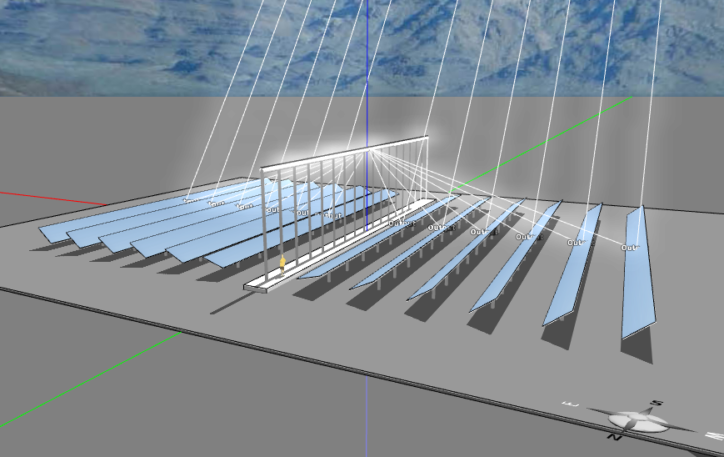
Fresnel reflectors, also referred to as concentrating linear Fresnel reflector, consist of thin, flat mirrors which work in the same manner as the other CSP systems. It concentrates sunlight onto the receiver via which a working fluid is pumped. The only difference is that Fresnel reflectors have flat reflectors which give more amount of reflective surface in the same space. This means that if we take two same space areas, and install parabolic mirrors in one and flat mirrors in another, the reflective surface in case of the flat mirrors will be more. Fresnel reflectors are cheaper than parabolic reflectors. They can also be installed in a variety of sizes of CSP systems.
